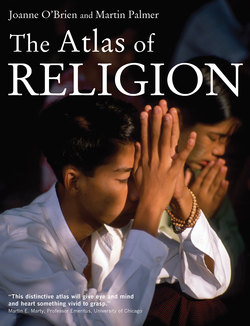Читать книгу The Atlas of Religion - Joanne O'Brien - Страница 45
На сайте Литреса книга снята с продажи.
ОглавлениеPart Three
STRUCTURES
All successful religions survive through the structures they have created over time. The original founder may provide the energy and vision, but it takes the next few generations to ensure the survival of the teachings. The Buddha, for example, was one teacher among hundreds, but his message survived because he created what are known as the Three Jewels: the Buddha, the Dharma (teachings and the true path) and the Sangha (the community of monks and nuns to preserve and pass on the teachings). Strong structures are especially important in the case of the major missionary faiths: the financing of Christian activities by the faithful, and the structure of Islamic Law are two examples. The apparatus involved in spreading the message plays a major role. Faiths have for a long time funded the publication of core texts, but increasing emphasis is being placed on media such as TV, radio and the internet as a means of structuring people’s encounter with core teachings. The relationship between State and religion can be controversial. For many people, the idea that a state should support a specific religion – through either funds or state-provided single-faith religious education – is anathema. The 18th-century insistence on the separation of Church and State, first espoused by the fledgling USA and taken up by France in its revolution, has now become a core tenet of secularism. Yet in Islamic countries such a notion is itself anathema, and almost all are Islamic in law, practice and politics. In Europe, the old Protestant ideal that the religion of the people should be reflected in a State Church and with a religious monarch has begun to diminish, but still is the norm for many countries in Northern Europe, while the Catholic countries of the South of Europe hold on to their position as officially Catholic. Elsewhere, most states that have emerged over the last 100 years, including Australia, Canada, Turkey, India and Angola, have opted for secular constitutions, in which all faiths are recognized and protected, but none is chosen as The Faith. It is through religious education that one can sometimes catch a glimpse of this complex relationship. For example, of the countries that emerged from the collapse of the Soviet Union and its satellites, most have opted for the secular approach. Kyrgyzstan, however, will not permit the teaching of religion or atheism in its state schools, while Afghanistan has opted for Islamic education.
Muslim female pilgrims visiting the citadel of Bam, Iran, prior to the earthquake that destroyed much of this ancient citadel in December 2003
